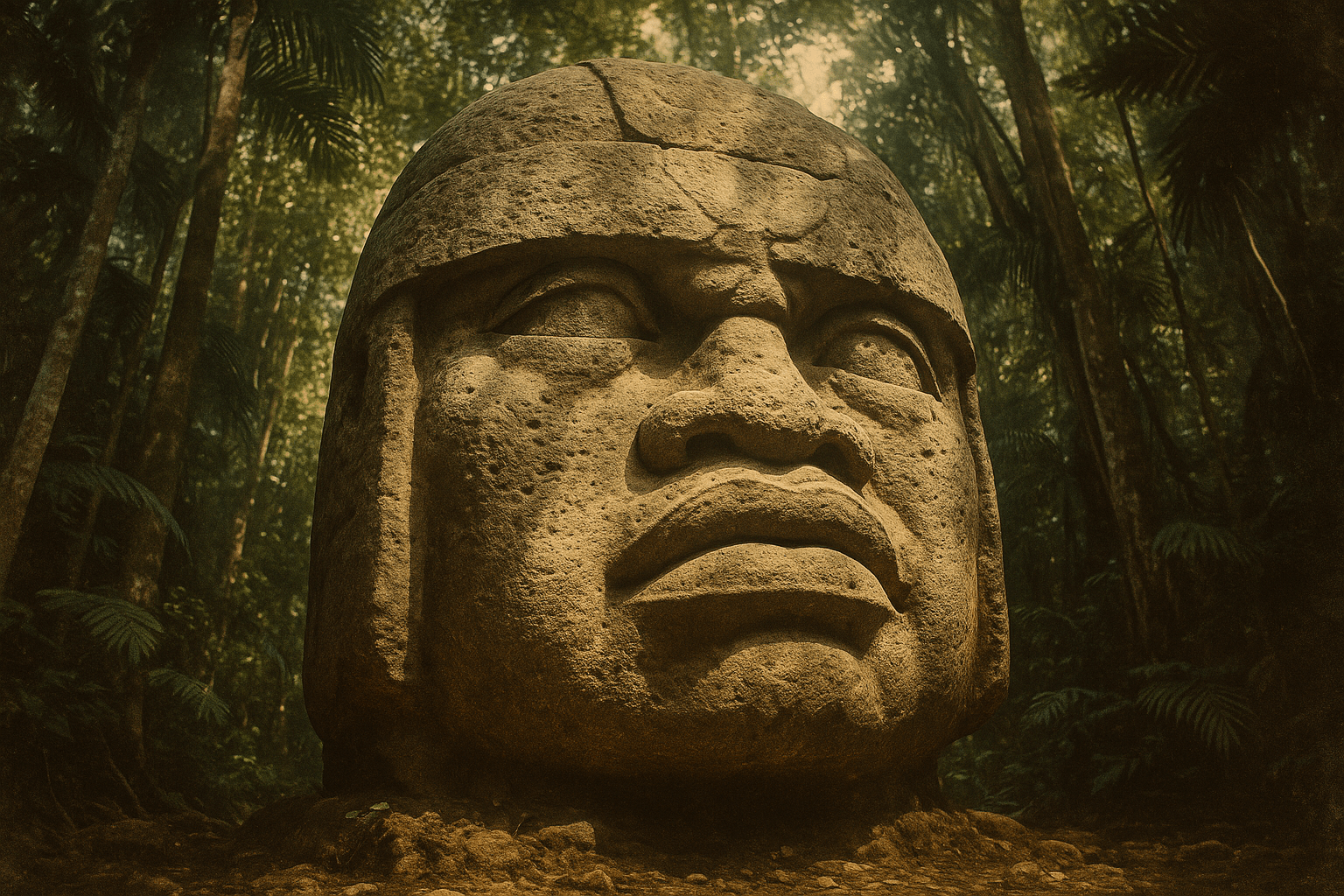Mesoamerica’s “Mother Culture”
To understand the heads, we must first understand their creators. The Olmec civilization flourished from approximately 1500 BCE to 400 BCE in the fertile river valleys of what are now the Mexican states of Veracruz and Tabasco. Often called the cultura madre, or “mother culture”, of Mesoamerica, the Olmecs were pioneers. They established cultural and societal templates that would be adapted and adopted by nearly every great civilization that followed.
Their innovations were foundational:
- They developed one of the earliest writing systems in the Americas.
- They practiced ritual bloodletting and played the famous Mesoamerican ballgame, both central tenets of later cultures.
- They created complex calendar systems and oriented their cities to align with celestial events.
- They built the first major ceremonial centers in the region, such as San Lorenzo Tenochtitlán and La Venta.
But of all their achievements, none capture the imagination quite like the colossal heads. These monuments are not just artifacts; they are a declaration of power, identity, and a level of social organization previously unseen in the Americas.
Portraits of Power Carved in Stone
Seventeen of these monumental sculptures have been unearthed to date, each one a unique masterpiece. They are massive, ranging in height from 5 to 11 feet and weighing anywhere from 6 to a staggering 50 tons. For perspective, a single large head weighs more than three adult African elephants. Each was carved from a single, enormous boulder of volcanic basalt.
What is most striking is their individuality. These are not generic representations of gods or archetypes; they are clearly portraits of specific human beings. Each face has distinct features, expressions, and, most importantly, a unique and elaborate headdress. These “helmets” are decorated with intricate carvings, possibly representing clan symbols, military triumphs, or titles of nobility. The subtle asymmetry of the faces and the detailed rendering of their features showcase an artistic skill that is nothing short of breathtaking. They appear so lifelike that one can almost feel the personality of the subject emerging from the stone.
An Engineering Enigma: A Herculean Task
The artistry of the heads is matched only by the mystery of their construction and transportation. The basalt stone used for the sculptures was not locally available. Geologists have traced the stone to the Sierra de los Tuxtlas mountains, an imposing volcanic range. The nearest Olmec center, San Lorenzo, was located nearly 60 miles away from these quarries.
This raises one of the greatest questions surrounding the Olmecs: how did they move these multi-ton blocks across miles of difficult terrain, including swamps, rivers, and dense jungle? The Olmecs had not invented the wheel for transport, nor did they have draft animals like horses or oxen to pull heavy loads. The feat would have required immense manpower and ingenious planning.
The most widely accepted theory suggests a combination of land and water transport. Archaeologists believe that hundreds, perhaps thousands, of laborers would have dragged the boulders overland using sledges and rollers made from logs. Upon reaching a river, the giant stones would have been loaded onto massive balsa wood rafts to be floated closer to their destination. The sheer scale of this operation—the quarrying, the carving (using only stone tools), and the transportation—speaks volumes about the power of the Olmec elite. Mobilizing such a labor force required a highly organized, hierarchical society with leaders capable of commanding immense resources and loyalty.
Who Were These Men of Mystery?
For decades, scholars debated the identity of the individuals immortalized in stone. Were they gods? Prized warriors? Champion ballplayers? Today, the overwhelming consensus among archaeologists is that the heads are portraits of powerful Olmec rulers.
Several pieces of evidence support this conclusion. First, the monumental effort required to create and transport a single head indicates that the subject must have been of supreme importance. Such a tribute was reserved for the highest echelons of society. Second, the individualized nature of the portraits suggests they commemorate specific leaders, perhaps the founders of dynasties. The unique headdresses likely served as emblems of their identity and authority, much like a European monarch’s crown.
Interestingly, many of the heads show signs of deliberate mutilation. Some have been defaced, pockmarked, or broken. This was not random vandalism. One theory suggests this was a form of “ritual killing” of the monument upon a ruler’s death, a way to neutralize the potent spirit and power contained within their stone likeness. Another theory posits that the damage was an act of iconoclasm, where a new ruler or a rival faction would desecrate the image of a predecessor to delegitimize their reign. A third, more practical explanation is that these giant stones were sometimes broken up and re-carved into new monuments, like thrones or altars.
A Silent, Enduring Legacy
The Olmec civilization declined around 400 BCE for reasons that remain unclear, possibly due to environmental changes or internal conflict. They left behind no grand libraries of written history, only the enigmatic clues embedded in their art and architecture. The colossal heads are their most powerful and lasting statement.
These stone faces have survived for three thousand years, silent witnesses to the rise and fall of empires. They are more than just archaeological artifacts; they are a testament to the ambition, ingenuity, and complexity of Mesoamerica’s first great civilization. While we may never know the names of the rulers they depict or all the secrets of their creation, the Olmec heads remain an awe-inspiring symbol of a lost world, forever guarding the mysteries of America’s ancient past.
